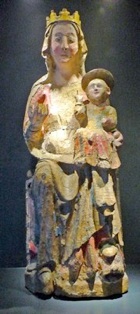

[Work by Michelangelo Braidi ??]
Works from San Girolamo
The following were removed from the Observant Franciscans' Convento di San Girolamo after the suppression of 1860.
Coronation of the Virgin (1486)
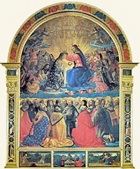
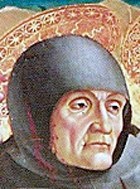
The altarpiece was painted in the Ghirlandaio workshop in Florence. It was on the high altar of San Girolamo until 1781, when it was moved to the wall of the apse. It was taken to Palazzo Comunale in 1871.
In the upper register of the main panel, Christ crowns the Virgin, surrounded by angels, many of whom play musical instruments, together with patriarchs and prophets. 22 saints in the lower register meditate on the scene The saints include:
-
✴St Francis, who kneels in prayer (at the centre) with the stigmata clearly visible in his hands and side;
-
✴St Jerome (the titular of the church), who wears a red cardinal's cope and looks out at the viewer (centre right);
-
✴St Antony of Padua, who kneels barefoot to the right of St Jerome;
-
✴St Bonaventure, who had been canonised in 1482 (centre left). Like St Louis of Toulouse to his left, he wears a sumptuous cope (indicating ecclesiastical office) over his Franciscan habit; and
-
✴St Bernardino of Siena, behind and immediately to the left of St Francis.
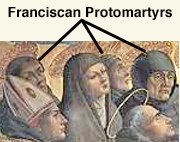
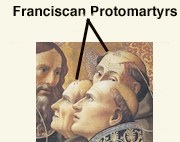
The figure behind St Bonaventure, who wears a black hood and has a head wound, is almost certainly St Berardo (the name saint of Cardinal Eroli, also illustrated above), one of the five Franciscan protomartyrs, who had been canonised in 1481. The other four protomartyrs, who also sport head wounds, are included in the composition (two on the extreme right and two to the left of St Berardo).
Three standing saints are depicted on each side of the frame. The predella depicts:
-
✴the stigmatisation of St Francis;
-
✴the Pietà; and
-
✴St Jerome in the dessert.
Madonna and Child with angels and saints (ca. 1470)
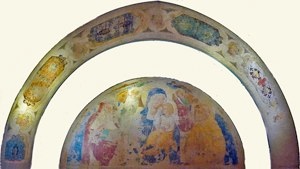
This damaged fresco, which came from the lunette of a portal of the church, is exhibited in together with the decorative frescoed cornice of the composition. The main scene, which depicts the Madonna and Child with SS Francis and Jerome, is attributed to Pierantonio Mezzastris. Cardinal Berardo Eroli, who financed the restoration of San Girolamo in 1465-71, probably commissioned these frescoes, at the same time that he commissioned those in what is now the Eroli Chapel, San Francesco.
St Antony of Padua and the Bl Bernardino (15th century)
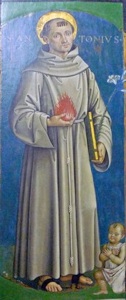
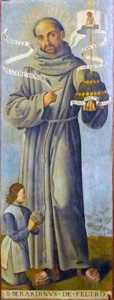
These altarpieces are attributed to a follower of Pier Matteo d’ Amelia.
-
✴St Antony holds a flame that symbolises his eloquence; and
-
✴the Blessed Bernardino of Feltro carries his usual attribute, the symbol of the Monte di Pietà.
Scenes from Via Crucis (1728-9)
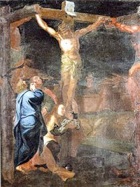
Works from San Domenico
The following works were removed from San Domenico, which passed to the ownership of the Commune in 1867.
Processional Banner (ca. 1400)
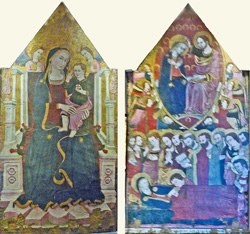
This double-sided panel, which is attributed to the Maestro di Narni del 1409, seems originally to have served served as a processional banner. It was first recorded in 1872 in the sacristy of San Domenico, although this was not necessarily its original location. It could be the banner from Santa Maria Impensole that was used in the annual procession held on the feast of the Assumption of the Virgin.
The panel, which was restored in 1989, depicts:
-
✴the Madonna and Child enthroned; and
-
✴the Dormition of the Virgin, with her Coronation above.
Three Angels (ca. 1400)
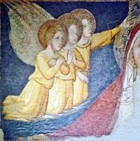
Annunciation (ca. 1450)
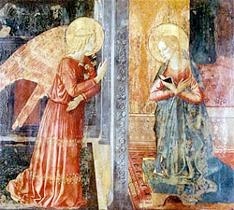
This signed altarpiece by Benozzo Gozzoli was restored in 1988. The foliage on the painted architecture at the centre of the composition is reminiscent of that on the Eroli arms, and it is possible that Cardinal Berardo Eroli was associated with the commission. The panel, which was recorded in 1872 in the second chapel on the left of the church, was most recently restored in 2002.
[This work was once more in restoration in 2010]
Madonna and Child with saints (ca. 1540)
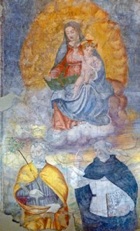
Last Supper (16th century)
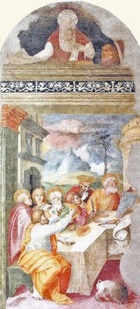
The detached frescoes exhibited here depict:
-
✴the left part of a scene of the Last Supper, with six of the disciples, including St Peter, brandishing a knife, and Judas, immediately behind him; and
-
✴St Jerome and his lion in the lunette above.
Other Works
Madonna and Child Enthroned (early 14th century)
St Bernardino of Siena (15th century)
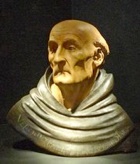
The bust was first documented in 1872 and again in 1898, when it was belonged to the Ospedale dei Proietti della Beata Lucia di Narni. It passed to the civic collection in 1969. It must originally have come from a Franciscan church, perhaps San Francesco or San Girolamo.
Resurrection (ca. 1500)
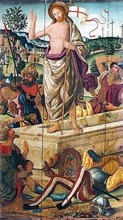
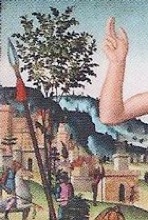
This damaged but recently restored panel was documented in the ownership of the Istituto Beata Lucia di Narni in 1872, but nothing is known of its original location. It seems to have been painted for a location in Narni: the cityscape to the left apparently represents the Rocca di Narni (at the extreme left), Porta Ternana (to the left of the spear) and presumably a gate that existed in the 16th century in front of the Arco Romano. The Institute still owns the panel, but it has allowed it to be displayed as part of the civic collection of Narni since 1969.
Marcantonio Aquili used a very similar composition for the central panel of a signed triptych (1511) for Santa Chiara, Rieti, which is now in the Museo Civico there. For this reason, the panel in Narni was also traditionally attributed to him. However, following its restoration, it is now attributed to his father, Antoniazzo Romano, whose cartoons Marcantonio habitually used. (This article in La Pagina describes the circumstances in which the new attribution was made).
Annunciation (1559)
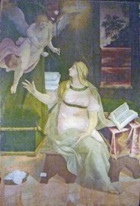
Scenes from the Life of St Benedict (1739)
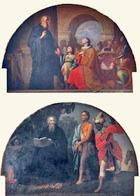
-
✴St Benedict welcoming a young novice (St Maurus or St Placidus) to his monastery (illustrated here) ;
-
✴St Benedict liberating a prisoner (also illustrated here);
-
✴Totila’s visit to St Benedict; and
-
✴the death of St Benedict.
Portraits of Gattamelata
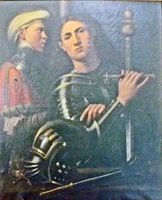
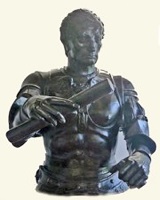
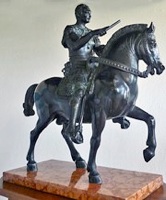
The Pinacoteca exhibits copies of two important portraits of the condottieri, Erasmo di Narni, called Gattamelata (died 1443):
-
✴a copy (early 19th century) of "A Warrior and his Equerry" (ca. 1509), a portrait generally attributed to Giorgione and thought to be of Gattamelata, which is now in the Uffizi Gallery, Florence; and
-
✴a copy (late 19th century) in bronze of the upper part of Donatello's equestrian statue of Gattamelata (1447-53), which stands in the Piazza del Santo, Padua.
It also displays an equestrian statue of Gattemelata that belonged to Giannetto Valli, who was Mayor of Narni in 1899-1902.
Egyptian Sarcophagus (5th or 4th century BC)
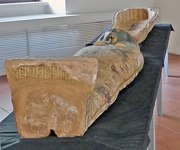
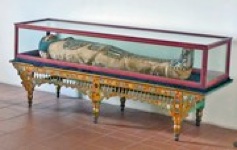
The inscription on this wooden sarcophagus records that it was originally used for the burial of Ramose, son of Amenhotep, priest of Horus. It therefore probably came from the necropolis of Edfu. It was later used for the mummy (4th century BC) of a young woman (displayed separately). The historian Edoardo Martinori brought the sarcophagus and its new mummy from Egypt to Narni in 1920, and his son subsequently gave them to the Commune.
Read more:
A. Novelli and L. Vignoli, "Arte a Narni tra Medioeo e Illuminismo", Perugia (2004)
C. Fratini et al., "Comunicare la Luce: Incoronazione della Vergine del Ghirlandaio a Narni", Perugia (2004)
Return to Museums of Narni.
Return to Walk I.
